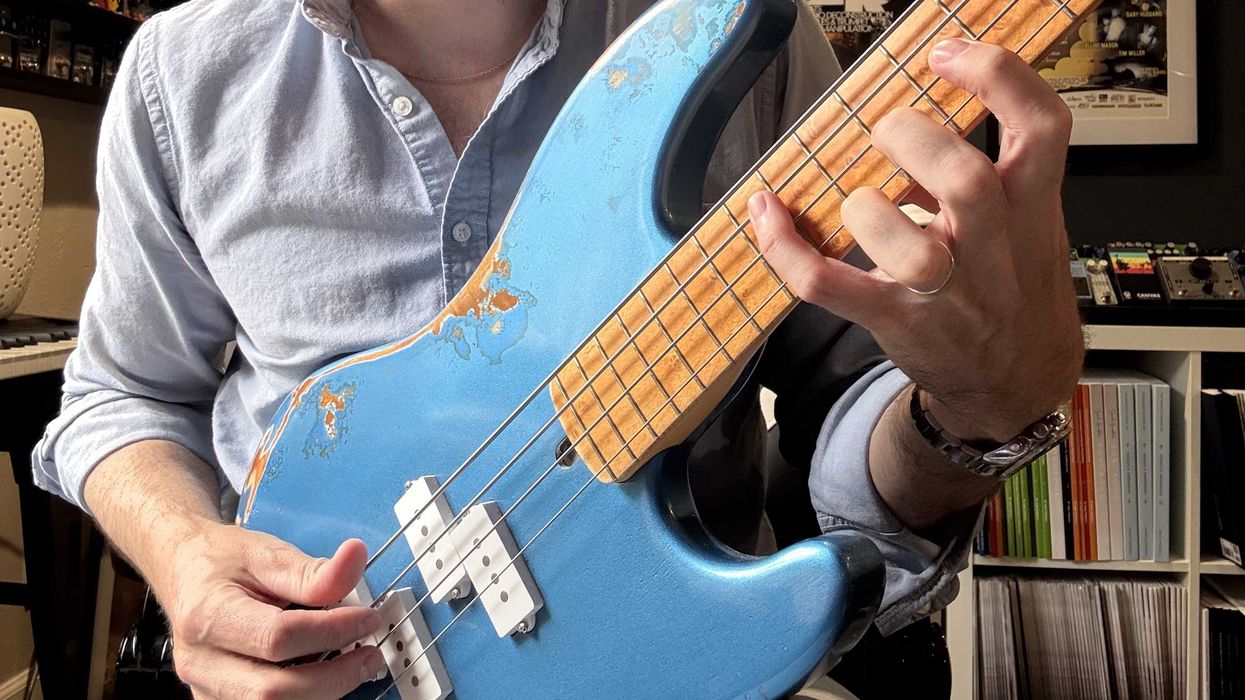There’s something wonderful about simple. Making music on a stripped-down, basic rig is exhilarating and, in a strange way, liberating. It’s like skinny dipping or sleeping in the nude: You’re just closer to everything. It’s something techie geekazoids don’t get. I love diving deep into computer apps that offer limitless options and capabilities, but when you bare your emotions onstage—or in the garage, for that matter—banging on an unadorned plank of wood through a loud amp is heaven on earth. Without the distraction and mental friction that multiple knobs, switches, and push-pull pots induce, you’re going commando—up close and personal with the here and now. Simplicity puts you in the moment.
Electric guitars started as quite straightforward devices. The first electrics were merely acoustic instruments with a pickup tacked on. Amps were crude and rude, and limited to tone and volume controls. What followed was a slow march towards the complicated, decorated, and deliciously diverse axedom that we know today.
At first, an onboard volume control seemed like a necessary upgrade to allow players to control performance levels on the fly. Early jazz-box electrics were eventually fitted with tone controls, multiple pickups with the requisite switchgear, and then with multiples of volume and tone controls. Amplifiers sprouted knobs for parameters like snowdrops in springtime. By the time amped-up instruments had been around 10 years, things were already getting complex compared to classical instruments. The 1960s saw builders add onboard fuzz, phase-shifter, and organ electronics.
The sweet spot. Somewhere in the middle of the timeline between the Vivi-Tone instruments of the early 1930s and the present, there was a sweet spot for simple electrics. Not better sounding or better playing, but Neanderthal, and possibly more rewarding. Their austerity encouraged creativity. Beginning with Fender’s single-pickup Esquire and ending, perhaps, with Van Halen’s Frankenstein, there was a period when there was a reverence for solidbody simplicity. Whether driven by lack of budget, simple tastes, or the appreciation of how marvelous a basic guitar can sound, the “student” instrument had a place at the vanguard of music.
Model students. From books and furniture to bicycles and pianos, almost anything you can imagine has been re-imagined in a young person’s scale. As early as the 1920s, Gibson was marketing smaller-bodied acoustics to beginners. Martin’s small-bodied 0-series guitars had existed since the 1840s, and although not specifically marketed to young people, it may have been the inspiration for Gibson’s student-model acoustics.
Sometimes we forget that both the 1959 Gibson Melody Maker and 1954 Les Paul were developed as budget models. Their unadorned designs saved money in manufacturing, but despite being the best-selling Gibson models in period, for years they went unloved as well. In 1960 there was also an extremely rare version of the Junior with a 22.5" scale. Although upper fret access is abysmal, these examples have a growl that is unique to the so-called 3/4 scale. For this reason, it’s one of my favorites. All of these Gibsons used the wraparound bridge, which contributes to their amazing sound and sustain.
In 1956, Fender introduced the Musicmaster, which was unabashedly marketed for kids. The Musicmaster’s short (22.5") scale and diminutive body made it less cumbersome for young people, and its bare-bones 3-saddle stamped bridge, single pickup, and two-control layout kept the price low, to the delight of parents. The Duo-Sonic and Mustang followed in this mold. The current interest in cut-rate models has urged Fender and others to reissue some of their most iconic student guitars. Players today appreciate the lower cost and simple layout of these instruments, which allow them to focus attention and funds on outboard effects. Musicians of all stripes have embraced these discount guitars for their, um, anti-corporate/attorney rock vibe. Ironically, student-guitar avatar Kurt Cobain sold 30 million copies of Nevermind.
However noteworthy this history may be, I like simple guitars because they help me enjoy the music. Without the temptation to continually “dial in” that perfect tone, I’m left to my finger technique to suit the mood. Relying on a single volume control for dynamics keeps me anchored to the groove at hand, and feeling the clang of strings unhindered by the magnetic damping created by multiple pickups is like driving a dragster—a one-trick pony, but oh, what a ride!
Just as the early electric rigs were reflections of the age they were born into, so, too, are today’s labyrinth of pickups, effects, switchgear, and computer-driven, mobile-device connected onboard and outboard options. Student guitars are once again part of the mix, whether for esthetics, finances, or their pure simplicity. I sometimes wonder if today’s young guitarists will find themselves in middle age, yearning for the quaint simplicity of Pro Tools and a modeling amp. “Old-school,” they’ll say wistfully, as they pick up their reissue Jag-Stang.
















